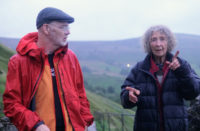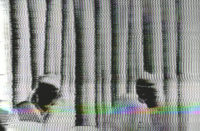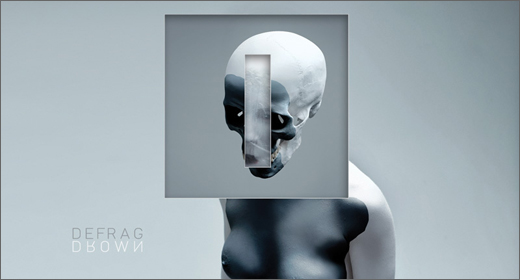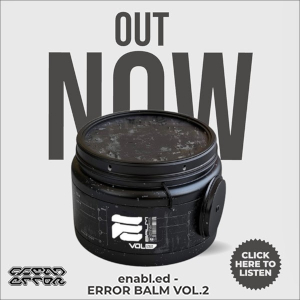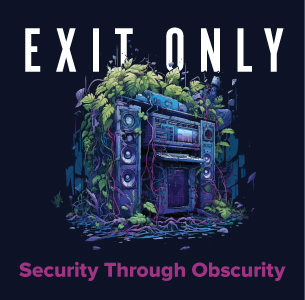The latest Defrag release takes the roots of electronic music and pushes them towards a more contemporary and overtly experimental direction. In support of this latest release, Igloo recently caught up with Jeff Dodson in order to gain an insight into his musical career to date, and also his leaning towards film.

Laced with percussive, bass driven escapades that exist in creative harmony
Idle Lines, the new release by Defrag (aka Jeff Dodson), is released on the Kaer’Uiks label—the label, we understand, was something that evolved from a live event series. Interestingly, it’s a German label, and for decades now, it’s as if Germany has had a long association with some of the roots of electronic music. The latest Defrag release, however, takes those roots and pushes them towards a more contemporary and overtly experimental direction. It’s laced with percussive, bass driven escapades that exist in creative harmony alongside the vibrant instrumentation exposures. The title track, in itself, is beautifully adventurous, with its vocal samples and electronic tuneful pulses set against a wide and varied landscape. “We are Foam” is bold and willing with powerful expression and a bouncy character. The whole soundtrack is full of expression—”A Space Inside” gives the impression of a feature length film entailing plenty of action, while “Crossing Under” is a curious water feature of blended sounds.
In support of this latest release, Igloo recently caught up with Jeff Dodson in order to gain an insight into his musical career to date, and also his leaning towards film.
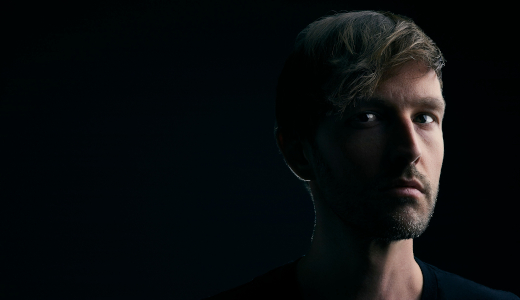
Sound design focused electronic music
Igloo :: For those who are not completely aware of Defrag—can you give us a quick synopsis?
Jeff Dodson :: Defrag started with breakcore and industrial roots but has since evolved into wherever my head is in the realm of electronic music and sound design. Frequently strong IDM influence, but my past and upcoming releases really flux between genres but share the same core signature feel.
Igloo :: Jeff, I understand Idle Lines could be considered a comeback of sorts, given your six-year hiatus. What have you been up to during that time, and what has driven this particular release? Was the crafting of a new set of material particularly challenging or was it just great to get stuck in again?
JD :: I’m ashamed that the 5-year release schedule seems to be my normal thing at this point. Something I’m working on rectifying. There’s currently 5 completed albums (including Idle Lines) releasing over the next few years. After the previous album (Drown, Hymen, 2014) my work in the trailer music and ad music field blew up and it has consumed my free time. Running my business Rainfall with my partners took a lot of my creative energy from doing personal projects, but as of recently I’ve been inspired to create again as Defrag. I needed the outlet of doing weird shit again. There’s hours of tracks old and new that needed to be released instead of hidden on a hard drive forever. Daniel contacted me about the possibility of doing a Defrag release on his label Kaer’Uiks. I had just been finalizing a release with Hymen and Daniel’s label was a good fit for some more cinematic / IDM focused tracks that I had been working on.
Igloo :: You’ve previously been involved in quite ambitious projects—the production of soundtrack score and sound design, an example being the Metroid short back in 2015? Given you’re also associated with Rainfall films, is this type of project fairly typical of your creative direction?
JD :: I’ve been super fortunate to work on some really great stuff over the years with Rainfall. Trailer and commercial music is the typical production for the audio side of Rainfall with several hundred syncs at this point. I’ve had some great opportunities like Rebranding Showtime TV, and G4, and staying at Skywalker ranch which aren’t everyday jobs for us. I got started ghost writing as a composer on some bigger AAA game titles (X-men, Neverwinter Nights) which was a great experience but not as rewarding as the freedom of sound design that trailer work provides. Metroid was a personal project that my partner Sam wanted to do, and since we produced the whole thing internally it allowed for total creative freedom from a score and sound design perspective. Rainfall is a mix of our talented which we also produce advertising motion graphics and VFX for an assortment of clients.

Cinematic and more complex programming
Igloo :: I’m guessing you’re classically trained, having started as a child playing piano? Would you say certain classical elements set good pathways for you in terms of creating drama with composition, as well as your excellent use of space to create atmospherics?
JD :: I was trained Suzuki method as a kid on Piano, which is a form of classical ear training. I think music theory training can be an exceptional tool in certain genres. Having a knowledge of where to take melody doesn’t hurt at all, but I don’t think it’s a requirement for producing sound design focused electronic music. For scoring and doing orchestral format music it’s essential, but it doesn’t necessarily make for better sound design which pulls from a different pool of creative tools in my opinion. Currently I’m working with a retired teacher from Berkley, Stuart Balcomb. I teach him production and software, he teaches me higher level music theory and ear training. A solid mutual deal that has improved my work enormously.
Igloo :: Do you find your template has grown as you’ve fused traditional classical composition skills with more technological based aspects such as programming? How do you successfully combine these elements to create your music and unique style?
JD :: I’m still exploring that for sure. I don’t feel the marriage of the two has clicked into a perfect style but the releases coming up, and including Idle Lines is more and more of an exploration in that realm. It’s been a challenge, sometimes I’ll focus on the intricate orchestral elements with sound design accents. Or fully develop a sound design focused piece that has minimal orchestral marks—it’s still a work in progress.
Igloo :: In terms of instrumentation and score, what do you feel creates good visual storyline and how do you set about the creative process?
JD :: The type of project dictates a lot of the creative process. For score, building a palette of sounds that works with the project on top of using those sounds to help build the emotion of whatever is occurring to hook the viewer is the goal. Most trailer work is done in reverse where the editor cuts the visuals to the music track, so it’s nice to be on both sides of that fence but it also makes for different approaches for how to compose the music. For a trailer track you have to build the sections that could be used for building tension and climax into the piece, where with score you have to follow the film makers edit and amplify that with the story through sound.
Igloo :: How does this release expand and build upon your past albums? Has there been any conceptual intention musically?
JD :: Idle Lines is a pretty conceptually logical step from Drown. It’s definitely more cinematic and has more complex programming but it’s also less dark. It’s strange and has a lot of melodic undertones wrapped in less traditional song formatting. Idle Lines is by design shorter, and to be taken all in one sitting. The 9 tracks play deliberately in order to express a flow through the release. All of my previous albums have that in mind, but with the landscape of music pushing towards shorter EP’s instead of LP’s it’s been a welcome change.
Igloo :: Your music is obviously very cinematic and lends itself well to film, is that intentional and something you’re keen to keep delving into?
JD: Absolutely. I have scored a few indie feature films, and lots of even shorter format ones, but whether we do it internally at Rainfall or connect with another director I’m looking forward to the right project to bring something unique to film score.
Igloo :: I guess my last question brings us nicely to Rainfall Films, your production company – great name by the way! Can you tell us about your inspirations, current projects of interest and aspirations? There are obvious synergies between your latest release and your Rainfall projects.
JD :: Actually, we’re pretty deep into a concept Defrag music video currently. Myself and my partners have always been primarily interested in doing films. Sam is a talented VFX artist and director, and it’s been a privilege to work on some of the projects we have together over the 8 years or so Rainfall has existed. Our aspirations have pretty much always been to make cool shit with cool people.
Igloo :: Is there anyone in particular you’d really like to work with (in music or film), that you haven’t had the opportunity to collaborate with as yet?
JD :: Oh absolutely. Musically I’d love to connect with Chris Clark, or Johann Johannsson before he passed, but this list would be enormous. I’m happy to work with anyone who is creatively making interesting work.
Igloo :: Is there any piece of music that you’d especially like to cover and put your own unique stamp on, that you think might be an interesting musical journey?
JD :: I’m going to go with Wicked Game by Chris Isaak. I think there’s huge potential for a strange modernized track here.

All over the spectrum of electronic music
Igloo :: Coming back to Idle Lines, your press release talks about seamlessly tying into earlier works—can you tell us about that particular dynamic?
JD :: Sure, Defrag at its core has always been me producing whatever I’ve felt like at the time. I’ve never been one for making side projects. I think part of the challenge as an artist is to push my own music forward but still have it respect previous works. Idle Lines is a very different release as people will hear, but it’s identity and fingerprint still sounds like a Defrag release. The way I approach cutting and manipulating sounds has a signature feel and that’s present here. “We Are Foam” has some bass inspiration from Lament Element (Hymen, 2009), but it’s used in a format that’s completely not like what music was in 2009. There’s cuts and sound design glitches on the opener “Still Marks,” that has a lot of inspiration from Drown (Hymen, 2014), but pushed. “Still Marks” is also in a few different time signatures so it’s all over. Sorry to anyone trying to spin that one.
Igloo :: Does a sense of place influence you at all? I know you were exposed to the Industrial Jungle scene of Brooklyn NY, and Idle Lines seems to make use of jungle themed basslines, as well as some very delicate and atmospheric sequences of course.
JD :: In terms of location of creation or placing the music into a scene? I guess either way the answer is no. I don’t really feel like I’m part of the LA electronic sound or something similar. Also, I don’t really feel like Defrag is a particular genre. It shares heavily from IDM I suppose, but the tracks have been all over the spectrum of electronic music. Each release is more of where I am at a place creatively as opposed to where the music is.
Igloo :: There’s a lot going on in your compositions—what influences do you draw upon? Is there anyone in particular who’s music or compositions you really admire?
JD :: I mentioned earlier that Clark and Johann are absolutely favourites of mine. I listen to a lot of film scores, although I don’t think it’s directly in my Defrag music but Sylvestri, Horner, Goldsmith are all incredible composers. Recently I’ve been listening to a lot of Jon Hopkins, Flying Lotus, Bibio, Teebs, Mefjus, Blank Banshee and Com Truise. All are masters in their genres imo.
Idle Lines is available on Kaer’Uiks. [Bandcamp]







